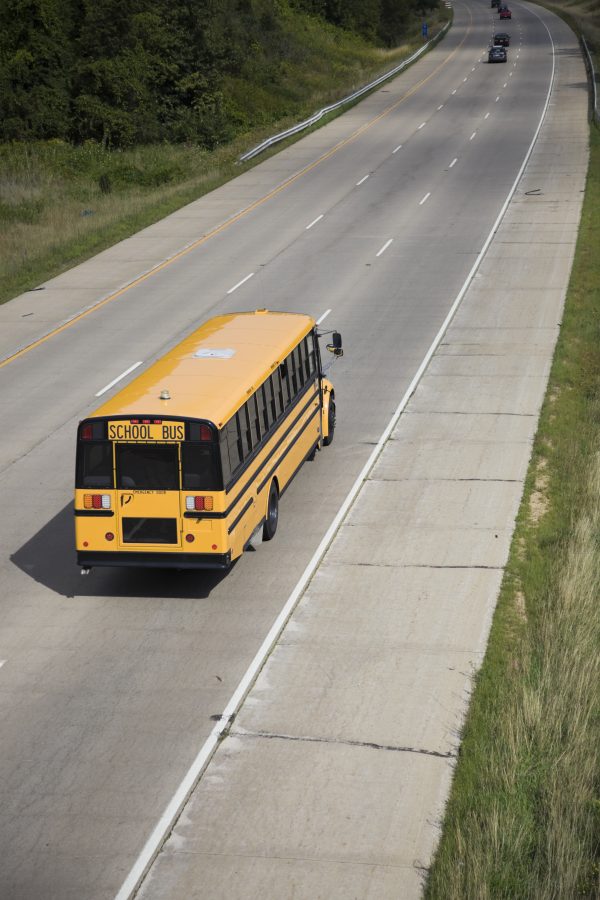At 4:05 p.m. the bell rings, and students spill into the halls making a beeline for cars, buses and other modes of transportation. Some, however, stay around for clubs, sports and extracurriculars. From slam poetry to track and field, RBHS offers 22 sports in addition to other activities from which to choose. Yet, unlike the Columbia Public Schools (CPS) middle schools, none of the four high schools offer a late activities bus. Whether it be in the form of walking, carpooling or bus riding, a student’s access to transportation may impact their level of involvement in certain activities. Junior Madison Polniak does not own a vehicle and said riding the bus to and from school each day makes participating in activities challenging.
“It is very inconvenient to go to clubs and stuff after school,” Polniak said, “especially because I don’t have transportation of my own, so I have to call my parents.”
If Polniak could find transportation, she would participate in more clubs, including Rock Bridge Reaches Out (RBRO) Humane Society. However, she said her parents only occasionally provide rides, and she does not have many other options.

“I do walk sometimes, but that takes a long time,” Polniak, who lives two miles from RBHS said, “and I’ll carpool when people offer, but that’s it.”
Although late activities buses, buses that provide transportation for activities taking place after the school day ends, do not run at the CPS high schools, Community Relations Director Michelle Baumstark said the district provides some form of extracurricular transportation, whether it be for field trips or athletics, at every school. In addition, she said students enrolled in Career Center classes have access to a shuttle bus.
“All schools provide some form of transportation for extracurricular activities. In elementary school, it’s transportation for field trips and special activities,” Baumstark said. “After school activity buses are currently run at all middle schools. Field trip, athletic, fine arts etc. also schedule buses for games and activities that happen off campus at all levels.”
All competitive Missouri State High School Activities Association (MSHSAA) activities receive transportation, Assistant Principal and Athletics Director David Egan said. He said examples of such activities include, but are not limited to, basketball, marching band, speech and debate and a wide range of sports.
“For any of those types of activities,” Egan said, “the school district provides a budget, and that budget money is used to help fund the buses needed to travel to competitions.”
However, Baumstark said although the district believes in providing a late activities bus to accommodate for students enrolled in tutoring and other activities, factors such as the increased number of activities and inconsistent meeting and practice times make this option difficult to provide at the high schools.
“There are a lot more activities at the high school level, but they all end at various times,” Baumstark said, “unlike middle school where there are fewer activities and they end at similar times. This would mean multiple late bus schedules that would likely run empty buses as many high schoolers start driving or have rides or alternative transportation options.”
While students such as Polniak must adjust their schedules accordingly, sophomore Dylan Gordon is among nearly 700 RBHS students who purchased a parking permit as of April, 2019. Every morning, Gordon pulls into the RBHS parking lot with his silver 2006 Chevy Malibu, a car he inherited from his grandmother. Gordon said owning a vehicle gives him control over his morning routine and even saves him a few minutes of sleep.
“[My car] allows me to get to band very easily and not have to be super early to certain things because I can come on my own time,” he said.
In addition to flexibility, Gordon said owning a vehicle provides crucial transportation that he would not have otherwise. According to the CPS Transportation Services Policy, the district provides transportation “for all resident students in grades 9-12 who reside two miles or more from the school to which they are assigned.”
Because Gordon lives closer than the required two-mile distance, he does not receive regular bus transportation. In addition, owning a vehicle enables him to participate in activities, such as Emerald Regiment and percussion rehearsals, where attendance is mandatory. Without a car, Gordon’s schedule would be compromised.
“[My car] allows me to get to band very easily and not have to be super early to certain things because I can come on my own time.” -dylan gordon, sophomore
“My parents would have to drop me off really early so they could get to work or I just would not go [to rehearsals],” Gordon said.
Polniak, however, does not have a choice. While Gordon arrives to school early for band practice, Polniak waits outside for the bus. Once on board, she pops in her earbuds for the duration of the wait.
“I always record [the bus ride] by songs,” Polniak said. “It takes about four songs, so I’d say [the ride takes] maybe like 15 minutes.”
Polniak said she already has her license. All she needs now is insurance and a car, which she expects to have sometime next year. She also said that while benefits exist for riding the bus, owning a car offers unique advantages that will come in handy for her internship class next year.
“[Taking the bus] is good school-wide just because it saves gas [and] it’s convenient just for everybody to be in the same area,” Polniak said. “It’s a good system, but there’s definitely some stuff I’d rather have a car for.”
How does transportation impact your schedule? Leave a comment below.













































































